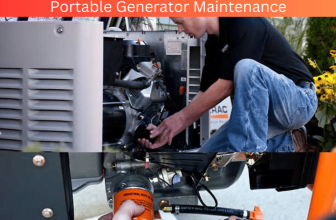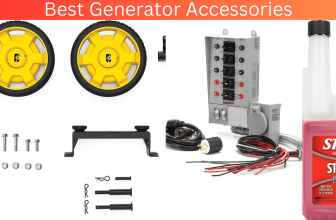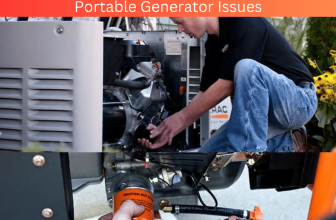
Portable generators are a great way to make sure you have reliable electricity, no matter where you are. But it’s important to understand that in order to keep your generator running smoothly and efficiently, you need to take care of it properly.
Taking the time to ensure your portable generator stays in top shape will pay off in the long run – and I’m here to show you how!
In this article, I’ll share some helpful tips on maintaining your portable generator so that it runs optimally for years to come.
From understanding the basics of generator maintenance and safety to checking oil levels and fuel filters, I’ll cover all the essentials for keeping your generator running like a champ.
So if you want your generator to function at its best, let’s get started!

Understanding The Basics Of Generator Maintenance
I’ve been using portable generators for a while now, and I understand how important keeping them in top shape is. However, many people don’t realize the importance of regular maintenance or don’t know where to start.
In this section, I want to provide some tips on understanding the basics of generator maintenance. The first step is to familiarize yourself with all the parts of your generator, as well as their functions. Knowing how each part works and interacts with the other components will help you spot any potential issues more quickly and accurately.
Additionally, it’s important that you check your manual for proper maintenance and safety protocols – these should be followed religiously so that your generator stays reliable over time. Finally, it’s essential that you use only genuine replacement parts when servicing your generator. Low-quality parts can cause serious damage if not properly installed or used incorrectly.
Ensure you buy from a reputable supplier with a good track record of providing quality products at competitive prices. With these steps in mind, you’ll be well on your way towards keeping your portable generator in top shape!
Establishing A Regular Maintenance Schedule
Now that you understand the basics of generator maintenance, it’s time to get serious about keeping your portable generator in shape. Regular maintenance is essential for preventing unnecessary repairs and ensuring a long life for your generator.
I’m here to tell you that establishing a regular maintenance schedule doesn’t have to be stressful. It just takes a little bit of organization and dedication.
First, set aside some time each month to inspect your generator. Check the air filter and fuel filter, as well as all hoses and connections, for any signs of damage or wear. Additionally, if your generator has spark plugs, take them out and check them for corrosion or cracks every couple of months. Wipe away any dirt or debris from the outside of the machine so nothing gets inside its housing.
It’s also essential to ensure that your generator is always using clean fuel and oil. Make sure to drain old fuel before storing the machine away during cold weather months, as well as check the oil level before every use. Doing these simple checks will help ensure that your generator runs smoothly when you need it most!
With a well-maintained machine, you can rest assured knowing that it’ll keep running no matter what comes your way. The time now to take a closer look at how to check the generator’s oil level…
Checking The Generator’s Oil Level
Hey there, you! Are you looking to keep your generator running like a well-oiled machine? It all starts with checking the oil level regularly. Taking just a few minutes every month to check the oil level in your generator can make all the difference between it running smoothly and it conking out on you when you need it most. Let’s review how to check the oil level and why it’s essential.
The first step is to locate the dipstick on your generator. It should be near the oil fill port and look like a small metal rod with a handle. Next, remove the dipstick from its holder and wipe off any excess oil with a cloth or paper towel. Then, reinsert the dipstick fully into its holder, making sure not to screw it in too tightly. After that, remove the dipstick again and check its reading:
| Level | Description | Action |
|---|---|---|
| Full | The oil is covering or close to covering the top mark on the dipstick | Remove some of the recommended types of oil until the full line is reached |
| Low | Oil is overflowing or close to overflowing top line on the dipstick | Oil is overflowing or close to overflowing the top line on the dipstick |
| Overfilled | No need for additional action; proceed to the next step | Remove some of the recommended type of oil until the full line is reached |
You must use only the recommended type of oil for your particular generator model. Do not mix different oils, as this can cause problems later down the road. And don’t forget to dispose of any used or excess engine oils properly – never pour them into rivers, streams or lakes! Now that you know how to check your generator’s oil level correctly, let’s move on to changing that oil regularly…
Changing The Oil Regularly
I can still remember the first time I had to change the oil in my portable generator. It was overwhelming at first, but it wasn’t as hard as I thought it would be once I got started.
Now, changing the oil regularly is a part of my regular maintenance routine and helps ensure that my generator is always running in top shape.
Changing the oil in your portable generator is an easy job that won’t take much time or effort. You’ll need an oil pan, wrench, and appropriate oil for the job.
Start by draining all the old oil out into the pan and then refilling with fresh oil. Tighten any loose bolts while you’re at it, and make sure everything is secure before turning on your generator again.
Regularly changing your generator’s oil will help extend its life and keep it running smoothly for years to come. Plus, you won’t have to worry about any nasty surprises when you start it up again after a long break—by maintaining your portable generator like this, you’ll avoid costly repairs.
Now let’s turn our attention to cleaning the air filter…
Cleaning The Air Filter
Taking care of your portable generator is essential to ensure it always works as it should. After all, you don’t want to be left in the dark when you need it most.
One of the best ways to ensure your generator is up to snuff is to clean its air filter regularly. It’s a relatively simple process that won’t take too much of your time and will help keep your generator running smoothly for years.
The first thing you need to do is locate the air filter on your generator. Depending on the make and model, this can usually be found either at the base or side of the unit.
Once you’ve located it, please remove it from its housing and use a soft-bristled brush or vacuum cleaner hose attachment to dislodge any dirt or debris that may have accumulated over time. Then use a damp cloth to wipe away any remaining dust or build-up.
Finally, give the air filter one last rinse with warm water and let it dry completely before placing it back in its housing. Make sure you reattach any clasps or screws securely so that nothing gets into the openings where dust can accumulate again.
With regular cleaning, your portable generator will stay in top shape for years to come!
Now that we’ve gone over how to clean an air filter let’s move on and examine the fuel lines and filters for any signs of wear or damage.
Examining The Fuel Lines And Filters
I want to ensure my generator stays in top shape, so I’m first checking the fuel lines and filters.
The fuel lines are what deliver the gas from the tank to the engine, so it’s important to make sure they’re clear of any clogs or dirt. If I find any blockages, I need to clean them out, as that could prevent my generator from running properly.
Next up is checking the fuel filter. The filter helps to remove impurities from the fuel before it enters the engine, ensuring a smoother operation. It’s important to replace this regularly, as a clogged or worn-out filter can reduce power output and cause damage to the carburettor or other sensitive parts.
Once I’m done inspecting and cleaning these two components, it’s time to move on and check out my generator’s battery.
By keeping an eye on these parts and taking good care of them, I can give my generator a longer life and more reliable performance.
Checking The Battery
Maintaining your portable generator is essential if you want it to last. A great place to start is by checking the battery. To do this, you’ll need some basic tools and supplies like a multimeter and a few wrenches.
Once you’ve got all the necessary equipment, look at the battery’s voltage. You can measure this with the multimeter by connecting its probes to the positive and negative terminals of the storm. Make sure to record the reading for reference so you can compare it later on. Here’s a table of recommended readings:
| Voltage Status | Voltage Reading |
|---|---|
| Fully Charged | 12.6V or higher |
| Low Battery | 11.8V – 12.5V |
| Dead Battery | <11.7 V |
If your measurement falls within any of these ranges, that’s great! If not, then it may be time to replace your battery or get it serviced by a professional before testing your generator further. From here, we’ll move on to testing the generator itself and making sure it’s in good working condition.
Testing The Generator
The first step in maintaining a generator is to test it. I always take my generator outside so I can see how it runs in a natural environment. I want to ensure that the engine starts up quickly and that the power output is consistent once the generator runs. I’ll also check for any wear or malfunctioning parts, such as frayed cables or loose connections.
After testing the generator, I’m confident that it will perform reliably when I need it.
Next, it’s time to protect the generator from the elements. This means making sure all exposed parts are properly sealed and covered to prevent rust and corrosion.
The fuel tank should be tightly sealed and topped off with fresh fuel whenever possible, and any wires and cables should be stored away securely when not in use.
Finallye any openings on the frame or enclosure of the generatey should be checked regularly for debris or other obstructions that could cause problems down the line.
By following these steps, my generator will stay in top shape and provide reliable power whenever I need it.
Protecting The Generator From The Elements
Taking care of your portable generator is key to ensuring it stays in top shape. One important factor is protecting the generator from the elements. To do this, there are several steps you can take:
| Prevention | Maintenance |
|:-:|:-:|
| Cover | Clean |
| Shield | Inspect |
| Store | Replace Parts |
| Use a Generator Shed | Lubricate |
| Waterproof Fuel Tank Cap | Tighten Connections and Bolts |
Taking these steps will ensure your generator stays dry and protected from rain, snow, wind, dust and other environmental hazards. Additionally, you should inspect your generator regularly for any signs of wear or damage.
If you find any problems, address them immediately by replacing parts or lubricating moving components. It’s also essential to make sure connections and bolts are tight and secure. However, the best way to protect your generator from the elements is to store it in a shed or cover it with a waterproof tarp when not in use.
This will helpremove dirt and debrisy while preventing rust buildup on metal surfaces.
In order to keep your portable generator running well for years to come, proper storage is essential. Let’s look at how best to store the generator properly…
Storing The Generator Properly
Now that we’ve protected the generator from the elements let’s talk about storing it properly. Storing your generator correctly is just as important as protecting it! You want to make sure that when you need it, it’ll be ready to go.
First and foremost, make sure your generator is completely dry before storing it. If there’s any moisture left on the surface, it could cause corrosion over time.
Also, wipe down the exterior with a clean cloth and some mild soap if needed. Then, use a light oil or lubricant to coat all moving parts and keep them in working order.
After ensuring that your generator is completely dry and lubricated, find a safe place to store it where temperature extremes are minimized. A dry area away from direct sunlight is ideal.
Additionally, always store your generator in an upright position so fuel doesn’t leak out and cause damage to other items in storage.
With these simple steps, you can ensure that your portable generator will remain in top shape for many yeame!
Frequently Asked Questions
How Often Should I Test My Generator?
Testing your generator regularly is key to ensuring it keeps running smoothly. Depending on your generator type, it’s recommended that you try it at least once every two weeks.
This will help you detect any problems before they get worse and can save you money in the long run.When testing your generator,o check for signs of wear and tear, like loose connections or frayed wirer.
By doing these routine checks, you’ll ensure your generator stays in top shape for years to come.
What Type Of Oil Should I Use For My Generator?
When it comes to your generator, the type of oil you use is important. Use an oil that has been specifically designed for use in portable generators – this will ensure the best performance and prevent any damage to your engine.
It’s important to check the manual to see what type of oil is recommended for your model, as different models may require different types of oil.
Generally, multi-viscosity oils are preferred as they can be used in a range of temperatures.
Make sure to change the oil regularly according to your manufacturer’s instructions so that your generator stays in top shape!
Are There Any Special Precautions I Should Take When Storing My Generator?
When it comes to storing your generator, there are a few things you should be aware of.
First, make sure you store it in a dry area away from extreme heat or cold.
And don’t forget to drain the fuel tank and add a fuel stabilizer to prevent corrosion.
It’s also important to keep the generator in an upright position when storing it so any residual oil or fuel doesn’t leak out.
Finally, if your generator has been in storage for an extended period of time, make sure to check all the nuts and bolts before using it again.
Taking these precautions will help ensure that your generator stays in top shape!
What Is The Best Way To Protect My Generator From The Elements?
Protecting your generator from the elements is important to keep it in top shape.
To do this, you should always store it in a dry location, preferably covered with a waterproof cover. Make sure the surface is secured so that wind and rain can’t get underneath it.
If you have to store it outside, elevate it off the ground on something like a pallet or cinder block.
You should also avoid exposing it to direct sunlight for prolonged periods, as too much heat can cause damage.
Is There Any Way To Prevent My Fuel Lines And Filters From Clogging?
Preventing your fuel lines and filters from clogging is an important part of maintaining your generator.
One way to do this is by using fuel stabilizers, which can help extend the life of your fuel and keep it from breaking down.
Additionally, you’ll want to inspect your fuel lines for any damage or leaks regularly.
If any are found, replace them as soon as possible.
Finally, be sure to drain the old fuel from your generator when it’s not in use for an extended period.
This will help keep the filter from clogging up and ensure that your generator runs smoothly over time.
Conclusion
It’s important to take good care of your portable generator if you want it to stay in top shape.
With regular testing, oil changes, and proper storage, you can ensure that your generator runs smoothly for years to come.
Taking the time to maintain your generator properly will also help you avoid costly repairs down the road.
With a few simple steps and periodic maintenance, you can ensure that your generator remains up and running when you need it most.
So don’t forget to keep your generator in peak condition – it’s worth the effort!





